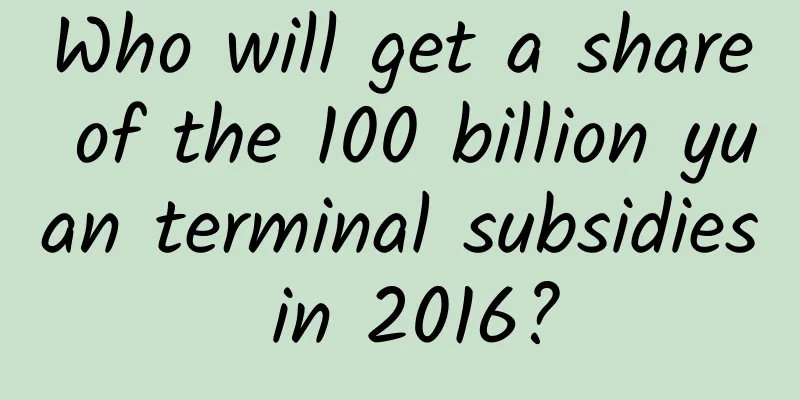Who will get a share of the 100 billion yuan terminal subsidies in 2016?

|
Source: NetEase Technology Original title: "Who can share the 100 billion terminal subsidies in 2016?" Author: Xiaoyu For terminal manufacturers, telecom operators are a "love-hate" existence: "love" because telecom operators have terminal cooperation plans worth hundreds of billions every year; "hate" because telecom operators in the 3G era are like "dominant overlords" who "have the final say". With the rise of Internet channels, terminal manufacturers have gradually formed their own brands, the voice of operators has weakened, and operator channels are no longer a "god-like existence" for terminal manufacturers. The terminal cooperation plans of the three major telecom operators have all been released in 2016. China Mobile's terminal cooperation alone involves 100 billion yuan, plus China Telecom's 7 billion yuan and China Unicom's 45 billion yuan. With a total of hundreds of billions of yuan, can they recreate the myth of "China Cool Union"? “Terminal manufacturers used to eat meat, but now they can only drink soup” In the 3G era, telecom operators created the "China Cool Alliance" four kings, allowing domestic mobile phone manufacturers to survive under the siege of many international brands, and some manufacturers even formed the most primitive capital accumulation. "Although the operators' terminal customization has left some problems, such as too many pre-installed applications on customized terminals and excessive user complaints, it has to be said that the operator's policy has achieved 'killing three birds with one stone'. At that time, smartphones were relatively expensive, and telecom operators' terminal customization not only lowered the threshold for users to use smartphones, but also drove the growth of mobile data traffic and supported a number of mobile phone manufacturers," said an operator who wished to remain anonymous. However, operators are both the cause of success and the cause of failure. In 2014, the State-owned Assets Supervision and Administration Commission required operators to reduce marketing expenses by 20% each year over the next three years and to reduce terminal subsidies. Some terminal manufacturers that were too dependent on operator channels were hit hard by the reduction in subsidies. The terminal cooperation plans of the three major telecom operators in 2016 have been released: China Mobile, the "big boss" of terminal subsidies, said it will maintain a strength that matches its user scale, and the total amount of mobile phone subsidies + discounts and channel remuneration will exceed 100 billion; China Unicom mentioned that it will subsidize users with 45 billion yuan on terminals in 2016, and will achieve a sales target of 150 million through open customization, unified supply and chain operations; China Telecom launched the "Excellence 100" plan in 2016, bringing together 7 billion yuan in seven incentive funds to deposit into terminal sales. The terminal cooperation plan worth hundreds of billions of yuan has attracted the attention of every mobile phone manufacturer. At the terminal partner conference of the three operators, terminal manufacturers have "expressed their loyalty" and fully supported the operators' requirements for terminals. From the outside, this seems to be another opportunity to create the "Four Heavenly Kings". However, interpretations from industry insiders indicate that the subsidy recipients of the terminal cooperation plan of the operators have been significantly adjusted, from subsidizing the product side of terminal manufacturers to subsidizing the channel side and user side. "A very important trend next year will be user-centricity. It has become a consensus among the three major operators to promote user migration from 2G/3G to 4G." GfK analyst Wu Xiaofeng told NetEase Technology. As early as 2013, the telecommunications industry had entered the era of "stock competition", with the growth rate of new users declining and the demographic dividend no longer existing. In the 4G era, telecommunications operators are facing the pressure of developing 4G users. In 2016, China Mobile stated that it would achieve a scale of 500 million 4G users, which requires the migration of existing users to 4G. Li Huidi, vice president of China Mobile, also said that China Mobile still has more than 500 million 2G and 3G users, and half of them are still functional. Therefore, China Mobile needs to launch more 4G products that meet the needs and help 2G and 3G users migrate to 4G. "From this point of view, the core demand for operators is users. In the 3G era, operators could acquire users through customized terminals, but in the 4G era, the marginal benefits of operators acquiring users through terminals have decreased. Therefore, operators are gradually shifting their focus from terminal products to users and channels in terminal cooperation," Wu Xiaofeng believes. In this regard, Cheng Hui, a telecom expert who has been observing the industry for a long time, also believes that with the launch of multi-mode, multi-frequency dual-SIM phones, users no longer choose mobile phones based on standards or operators. Without changing their phones, users can freely switch services between multiple operators, and market competition has also changed from "standard competition" to "card slot competition." Therefore, the terminal subsidy methods of operators are different from the past. For example, terminal subsidies are open, and they no longer subsidize terminals but packages. Judging from the smartphones currently launched by domestic manufacturers, full network access has basically become the standard configuration of mid-to-high-end smartphones. "For operators, selling a new phone does not necessarily mean acquiring a user, but channels can help operators develop users. This means that with the same cost subsidies, subsidizing channels can gain user benefits, so why not?" said an industry expert. "If terminal manufacturers could get a share of the 'meat' from operator terminal subsidies in the 3G era, now they can only 'drink the soup'." It is difficult to control the strength of operator channels For terminal manufacturers, although they can only "drink soup" from the operators' hundreds of billions of subsidies, it is also an important channel that cannot be given up. "For many terminal manufacturers, operator channels are still very important. On the one hand, operators have rich industry resources; on the other hand, some terminal manufacturers want to cover third- and fourth-tier cities, but do not have good coverage capabilities, so they must rely on the power of third parties. In addition to traditional agents, operator cooperative stores are also a very important channel." Wu Xiaofeng said. Cheng Hui also believes that the operator's offline business halls may also be transformed into terminal experience halls. Industry insiders revealed that OPPO increased its investment in operator channels in 2015, which created a new growth point. Therefore, the insider reminded that although operator channels are no longer as important as before, the development paths of each manufacturer are different, and the degree of cooperation with operators will also be different. "It is very important to strike the right balance in cooperation with operators. If you get too close, it will be difficult for the operators to recover once they fail to provide blood transfusions. There have been precedents. If you get too far, the channels will become a shortcoming. It's like a bucket. How much water it can hold depends on the shortest board," explained an analyst. These will become the trend In addition, judging from the requirements of the three major operators for terminal cooperation, terminal mobile phones will gradually be equipped with VoLTE, CA and NFC functions next year. China Mobile is undoubtedly the most demanding in terms of VoLTE configuration. It has already built 1 million 4G base stations and will build 300,000 new 4G base stations in 2016 to achieve deep indoor coverage and continuous urban coverage. It is expected that VoLTE will be commercially available in about 260 cities by June 2016. China Unicom's 2016 terminal subsidies also mentioned that VoLTE and VoWiFi terminals can enjoy subsidies of 1-2 billion yuan, with a specific subsidy standard of 10-30 yuan per unit. In addition, in order to achieve the requirements of speed increase and fee reduction, the three major operators launched the trial commercial use of "4G+" in 2015, increasing the speed of the network and also requiring mobile terminals to support CA (carrier aggregation). China Unicom, China Mobile and China Telecom have all stated that they will subsidize terminals that support CA. NFC mobile payment function is an important category of China Mobile's terminal subsidies in 2016. China Mobile is making every effort to promote the standard configuration of NFC and L+C functions in mobile phones, and hopes that manufacturers will put NFC-USIM cards into the boxes. In response, China Mobile will provide 15 yuan per user for NFC service. In addition, China Mobile will also reward NFC as a key subsidy service to channel dealers. In short, for terminal manufacturers, operator channels are an indispensable part, but an effective cooperative distance must be maintained. As a winner of Toutiao's Qingyun Plan and Baijiahao's Bai+ Plan, the 2019 Baidu Digital Author of the Year, the Baijiahao's Most Popular Author in the Technology Field, the 2019 Sogou Technology and Culture Author, and the 2021 Baijiahao Quarterly Influential Creator, he has won many awards, including the 2013 Sohu Best Industry Media Person, the 2015 China New Media Entrepreneurship Competition Beijing Third Place, the 2015 Guangmang Experience Award, the 2015 China New Media Entrepreneurship Competition Finals Third Place, and the 2018 Baidu Dynamic Annual Powerful Celebrity. |
>>: Brave New World Unreachable How difficult is it to make a VR movie?
Recommend
Xiaomi Auto sets its first FLAG for 2025 - to deliver 300,000 vehicles. Whose share will be eaten up?
After entering the stock market, if anyone in the...
With over 10 million daily active users, how does Qutoutiao operate?
As Pinduoduo went public and its stock price soar...
What, a social cow can live a long life?
Produced by: Science Popularization China Author:...
Can the unused electricity be stored?
This summer, Sichuan has been experiencing contin...
Based on the phenomenon of product homogeneity, can operations personnel become the main force in product development?
Generally speaking, the product-related positions...
Tik Tok offers free certification for a limited time at 0 Yuan! You can conduct business from home during the epidemic! If you miss it, you have to wait until next year!
Recently, Douyin officially announced within the ...
Carbon dioxide can be used to make plastics? You heard it right!
Author: Li Chuanfu Shi Xiangqi As the global clim...
How do Tik Tok influencers create hits?
Summer is here, and Douyin's "Comprehens...
Is there a chance for humans to slow down or stop aging and thus extend their lifespan?
If we first want to define the personality of the...
How much does it cost to be an agent for a home furnishing mini program in Fuxin?
How much does it cost to be an agent for a home f...
Why are we still so keen on “detoxification” today?
In terms of health care, "detoxification&quo...
The top ten evolutionary "weirdos" in nature, each one more outrageous than the other (Part 1)
Ailsa Harvey In the vast history of biological ev...
In order to accurately locate the position of flies in the house, he invented the rectangular coordinate system
Produced by: Science Popularization China Produce...
Sincere advice: Walking more than 7,000 steps a day can significantly reduce the mortality rate!
As the saying goes, if you take a hundred steps a...
Are pop-ups in software annoying? You have to be honest now
The Cyberspace Administration of China, the Minis...









